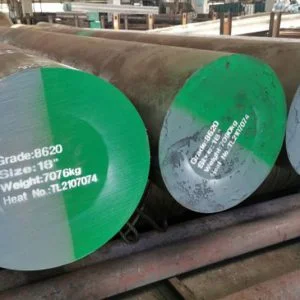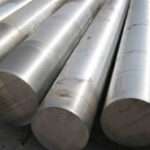Introduction

In the realm of metallurgy, the heat treatment of 8620 steel stands as a crucial process for enhancing its mechanical properties. This blog delves into the intricacies of this treatment method, elucidating its significance and impact on the performance of 8620 steel components.
Understanding 8620 Steel
8620 steel, a low-alloy steel, renowned for its exceptional toughness and wear resistance, finds widespread application in various industries, including automotive, aerospace, and machinery manufacturing. Its composition primarily comprises iron, carbon, chromium, nickel, and molybdenum, imparting favorable mechanical properties suitable for demanding applications.
Heat Treatment Techniques for 8620 Steel
Annealing
Annealing is a critical heat treatment process for 8620 steel. It involves heating the steel to a specific temperature range, typically between 1500°F and 1600°F (815°C to 870°C), depending on the desired properties and the alloy’s composition. Once the steel reaches this temperature, it is held there for a predetermined period to ensure homogenization of the microstructure.
Controlled cooling is then employed to alleviate internal stresses within the steel. Slow cooling in a furnace or air cooling is often utilized to achieve the desired results. Annealing not only relieves internal stresses but also improves the machinability of 8620 steel, making it easier to work with during subsequent manufacturing processes.
Normalizing
Normalizing is another essential heat treatment technique applied to 8620 steel. This process aims to refine the grain structure of the steel by heating it to a temperature above its critical point, typically around 1600°F to 1700°F (870°C to 925°C), depending on the alloy composition and desired outcomes.
Once the steel reaches the critical temperature, it is held there for a specific duration to ensure uniform heating throughout the material. Air cooling is then employed to achieve the desired microstructural transformation. Normalizing helps to improve the strength and uniformity of 8620 steel, making it more suitable for applications requiring enhanced mechanical properties.
Quenching and Tempering
Quenching involves rapid cooling of the steel from an elevated temperature, typically above its critical point, to induce martensitic transformation. This rapid cooling can be achieved using various quenching mediums such as oil, water, or polymer solutions. The choice of quenching medium depends on factors such as the desired hardness, part geometry, and heat treatment specifications.
Following quenching, the steel is tempered by reheating it to a specific temperature range, typically between 300°F to 700°F (150°C to 370°C), depending on the desired properties. Tempering helps to reduce the brittleness induced by quenching while maintaining the desirable mechanical properties. This process allows for the adjustment of hardness, strength, and toughness to meet the requirements of the intended application.
Factors Influencing Heat Treatment
- Temperature: Precise control of heating and cooling temperatures is paramount in the heat treatment of 8620 steel. The temperature at which the steel is heated and the rate at which it is cooled directly influence its microstructure and, consequently, its mechanical properties. Variations in temperature can lead to inconsistencies in the final product’s hardness, strength, and toughness. Therefore, meticulous monitoring and control of temperature profiles throughout the heat treatment process are essential to ensure uniformity and repeatability.
- Cooling Rate: The cooling rate during the heat treatment process profoundly affects the final properties of 8620 steel. Rapid cooling, such as in quenching, results in the formation of a martensitic microstructure, characterized by high hardness and brittleness. On the other hand, slower cooling rates, as observed in annealing or normalizing, promote the formation of finer grain structures, enhancing toughness and ductility. The choice of cooling rate depends on the desired balance of mechanical properties required for the specific application. Factors such as part geometry, section thickness, and alloy composition also influence the optimal cooling rate.
- Quenching Medium: The selection of an appropriate quenching medium is crucial in determining the hardenability of 8620 steel. Hardenability refers to the steel’s ability to form martensite during quenching, influencing its final hardness and strength. Common quenching mediums include water, oil, and polymer solutions, each offering different cooling rates and resulting in varying microstructures. Water quenching provides the most rapid cooling rate, producing high hardness but also increasing the risk of distortion and cracking. Oil quenching offers a moderate cooling rate, balancing hardness and toughness, while polymer solutions can be tailored to specific cooling rates to achieve desired properties. The choice of quenching medium depends on factors such as the steel’s composition, part geometry, and heat treatment specifications, with careful consideration given to achieving the desired balance of properties without compromising part integrity.
Effects of Heat Treatment on Mechanical Properties

| Mechanical Property | Annealed | Normalized | Quenched & Tempered |
|---|---|---|---|
| Hardness (HRC) | Moderate | Moderate | High |
| Strength | Low | Moderate | High |
| Toughness | High | High | Moderate |
Conclusion
The heat treatment of 8620 steel is a nuanced process that profoundly influences its mechanical properties and performance characteristics. By employing suitable techniques and meticulous control over parameters, manufacturers can tailor the properties of 8620 steel to meet diverse application requirements, ensuring optimal performance and durability.
FAQ
Q: What are the typical applications of 8620 steel?
A: 8620 steel finds extensive use in manufacturing gears, shafts, and other components subjected to high stress and wear conditions, particularly in automotive and machinery industries.
Q: Can 8620 steel be welded after heat treatment?
A: Yes, 8620 steel can be welded post-heat treatment, although precautions should be taken to avoid altering the microstructure and properties of the heat-affected zone.
Q: What are the limitations of heat treatment on 8620 steel?
A: While heat treatment can significantly enhance the mechanical properties of 8620 steel, excessive heating or improper cooling may lead to distortion or cracking, necessitating careful process control and monitoring.
This comprehensive overview underscores the pivotal role of heat treatment in optimizing the performance of 8620 steel, offering insights into its methodologies, effects, and practical considerations.
